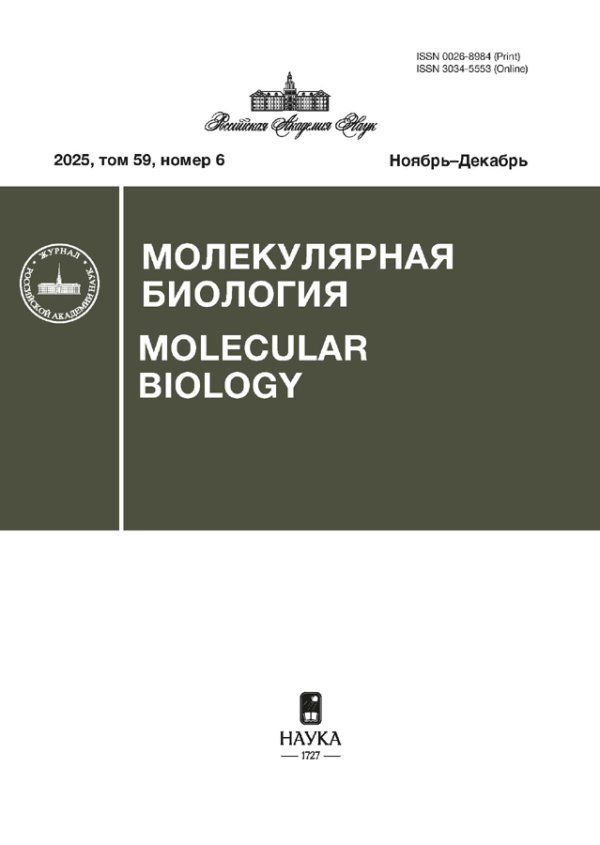Активность антирестрикционного белка ArdB в отношении эндонуклеазы EcoAI
- Авторы: Кудрявцева А.А.1, Алехин В.А.1, Лебедева М.Д.2, Csefalvay E.3, Weiserova M.4, Манухов И.В.1,5
-
Учреждения:
- Московский физико-технический институт (Национальный исследовательский университет)
- Автономная некоммерческая общеобразовательная организация “Физтех-лицей” им. П.Л. Капицы
- Laboratory of Structural Biology and Bioinformatics, Institute of Microbiology, Academy of Sciences of the Czech Republic
- Institute of Microbiology, Academy of Sciences of the Czech Republic
- Московский государственный университет пищевых производств
- Выпуск: Том 57, № 1 (2023)
- Страницы: 101-105
- Раздел: МОЛЕКУЛЯРНАЯ БИОЛОГИЯ КЛЕТКИ
- URL: https://journals.rcsi.science/0026-8984/article/view/138616
- DOI: https://doi.org/10.31857/S0026898423010056
- EDN: https://elibrary.ru/AWVMVU
- ID: 138616
Цитировать
Полный текст
Аннотация
Белки семейства ArdB подавляют активность белков системы рестрикции–модификации I типа (RM-I). Механизм действия ArdB к настоящему моменту остается неизвестным; спектр ингибируемых ими мишеней исследован недостаточно. Нами показано, что присутствие гена ardB из конъюгативной плазмиды R64 подавляет активность EcoAI – представителя семейства IB системы рестрикции–модификации. Ввиду обнаруженного отсутствия специфичности ArdB к определенному семейству рестриктаз системы RM-I (ингибирует как IA-, так и IB-семейство) можно предполагать, что механизм антирестрикционной активности этого белка не зависит от последовательности как ДНК в сайте узнавания, так и структуры рестриктазы системы RM-I.
Ключевые слова
Об авторах
А. А. Кудрявцева
Московский физико-технический институт (Национальный исследовательский университет)
Автор, ответственный за переписку.
Email: kudryavtseva@phystech.edu
Россия, 141707, Московская обл., Долгопрудный
В. А. Алехин
Московский физико-технический институт (Национальный исследовательский университет)
Email: kudryavtseva@phystech.edu
Россия, 141707, Московская обл., Долгопрудный
М. Д. Лебедева
Автономная некоммерческая общеобразовательная организация “Физтех-лицей” им. П.Л. Капицы
Email: kudryavtseva@phystech.edu
Россия, 141707, Московская обл., Долгопрудный
E. Csefalvay
Laboratory of Structural Biology and Bioinformatics, Institute of Microbiology, Academy of Sciences of the Czech Republic
Email: kudryavtseva@phystech.edu
Czech Republic, 37333, Nove Hrady, Zamek 136
M. Weiserova
Institute of Microbiology, Academy of Sciences of the Czech Republic
Email: kudryavtseva@phystech.edu
Czech Republic, 14220, Praha 4, Vídeňská 1083
И. В. Манухов
Московский физико-технический институт (Национальный исследовательский университет); Московский государственный университет пищевых производств
Email: kudryavtseva@phystech.edu
Россия, 141707, Московская обл., Долгопрудный; Россия, 125080, Москва
Список литературы
- Samson J.E., Magadán A.H., Moineau S., Sabri M. (2013) Revenge of the phages: defeating bacterial defences. Nat. Rev. Microbiol. 11, 675‒687.
- Tock M.R., Dryden D.T. (2005) The biology of restriction and anti-restriction. Curr. Opin. Microbiol. 8, 466–472.
- Liang W., Xie Y., Lu Y, Xiong W., Tang Y., Li G., Jiang X., Lu Y. (2017) Anti-restriction protein, KlcAHS, promotes dissemination of carbapenem resistance. Front. Cell. Infect. Microbiol. 7, 150.
- McMahon S.A., Roberts G.A., Johnson K.A., Cooper L.P., Liu H., White J.H., Carter L.G., Sanghvi B., Oke M., Walkinshaw M.D., Blakely G.W., Naismith J.H., Dryden D.T. (2009) Extensive DNA mimicry by the ArdA anti-restriction protein and its role in the spread of antibiotic resistance. Nucleic Acids Res. 37, 4887–4897.
- Roberts G.A., Stephanou A.S., Kanwar N., Dawson A., Cooper L.P., Chen K., Nutley M., Cooper A., Blakely G.W., Dryden D.T. (2012) Exploring the DNA mimicry of the Ocr protein of phage T7. Nucleic Acids Res. 40, 8129–8143.
- Goryanin I.I., Kudryavtseva A.A., Balabanov V.P., Biryukova V.S., Manukhov I.V., Zavilgelsky G.B. (2018) Antirestriction activities of KlcA (RP4) and ArdB (R64) proteins. FEMS Microbiol. Lett. 365, fny227.
- Кудрявцева А.А., Охрименко И.С., Дидина В.С., Завильгельский Г.Б., Манухов И.В. (2020) Антирестрикционный белок ArdB (R64) взаимодействует с ДНК. Биохимия. 85, 369–377.
- Balabanov V.P., Kudryavtseva A.A., Melkina O.E., Pustovoit K.S., Khrulnova S.A., Zavilgelsky G.B. (2019) ArdB protective activity for unmodified λ phage against EcoKI restriction decreases in UV-treated Escherichia coli. Curr. Microbiol. 76, 1374–1378.
- Belogurov A.A., Delver E.P., Rodzevich O.V. (1993) Plasmid pKM101 encodes two nonhomologous antirestriction proteins (ArdA and ArdB) whose expression is controlled by homologous regulatory sequences. J. Bacteriol. 175, 4843–4850.
- Serfiotis-Mitsa D., Herbert A.P., Roberts G.A., Soares D.C., White J.H., Blakely G.W., Uhrín D., Dryden D.T. (2010) The structure of the KlcA and ArdB proteins reveals a novel fold and antirestriction activity against type I DNA restriction systems in vivo but not in vitro. Nucleic Acids Res. 38, 1723–1737.
- Маниатис Т., Фрич Э., Сэмбрук Дж. (1984) Молекулярное клонирование. Москва: Мир.
- Кудрявцева А.А., Осетрова М.С., Ливинюк В.Я., Манухов И.В., Завильгельский Г.Б. (2017) С-концевой остаток аспарагиновой кислоты (D141) необходим для антирестрикционной активности белка ArdB (R64). Молекуляр. биология. 51(5), 831–835.
- Завильгельский Г.Б., Мершавка В.Ю., Юсифов Т.Н., Белогуров А.А. (1984) Ослабление рестрикции ЕсоК ДНК бактериофага в присутствии плазмиды pKM101 ard+. I. Общая характеристика и генетическая локализация. Молекуляр. биология. 18(6), 1590–1596.
- Манухов И.В., Коноплева М.Н., Баженов С.В. (2016) Практикум по генетической инженерии. Черноголовка: Редакционно-издательский отдел ИПХФ РАН.
- Kan N.C., Lautenberger J.A., Edgell M.H., Hutchison C.A. (1979) The nucleotide sequence recognized by the Escherichia coli K12 restriction and modification enzymes. J. Mol. Biol. 130(2), 191–209. https://doi.org/10.1016/0022-2836(79)90426-1
- Kröger M., Hobom G. (1984) The nucleotide sequence recognized by the Escherichia coli A restriction and modification enzyme. Nucleic Acids Res. 12(2), 887–899. https://doi.org/10.1093/nar/12.2.887
Дополнительные файлы











